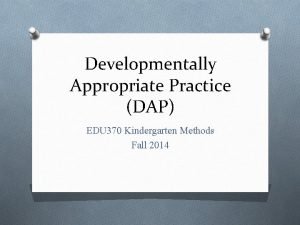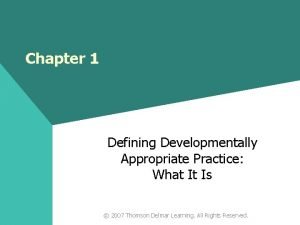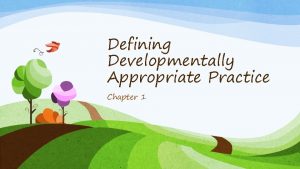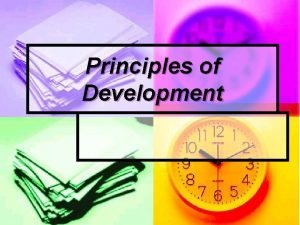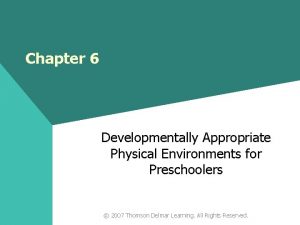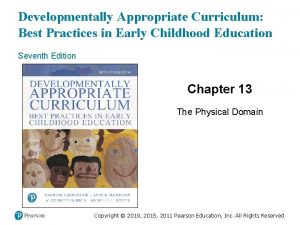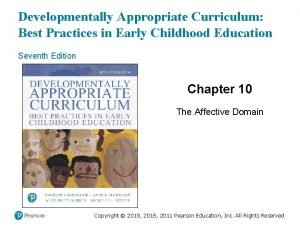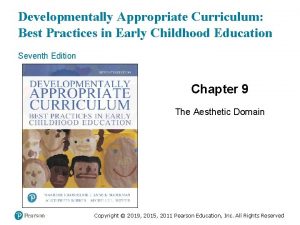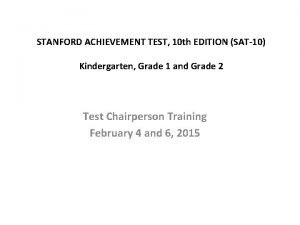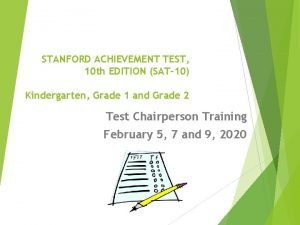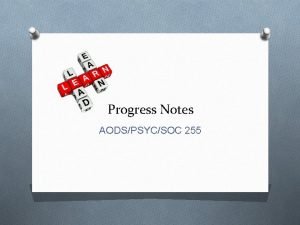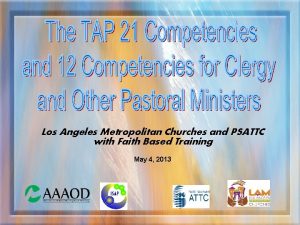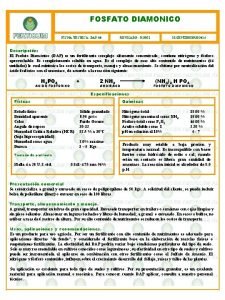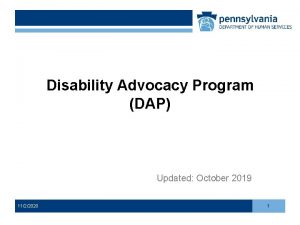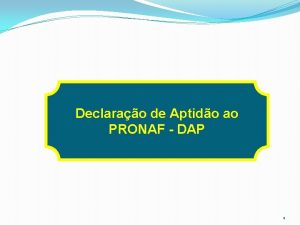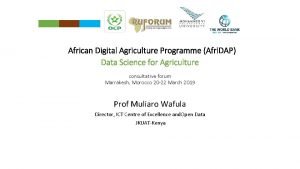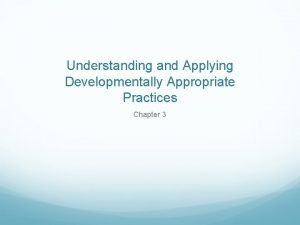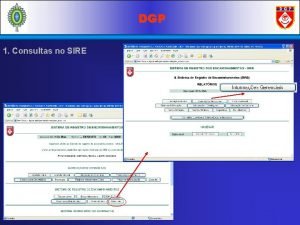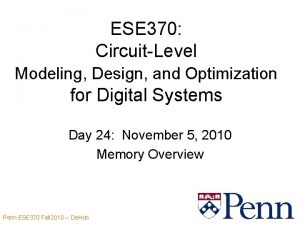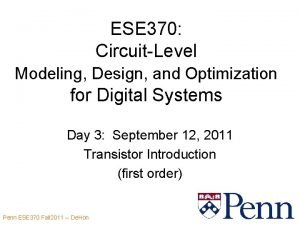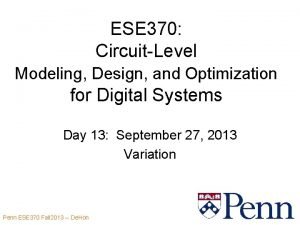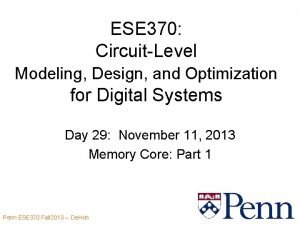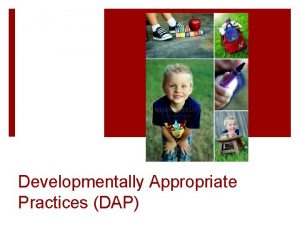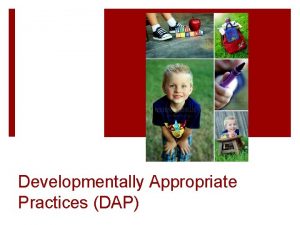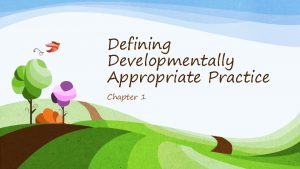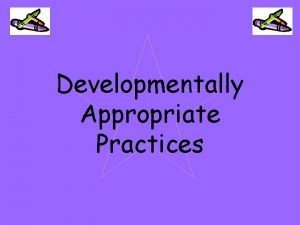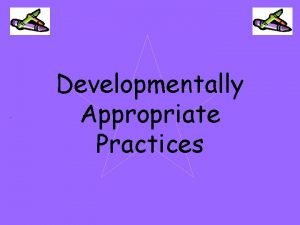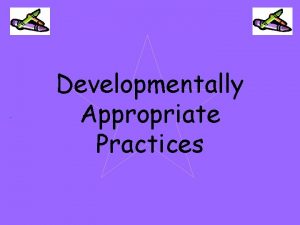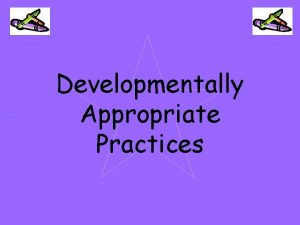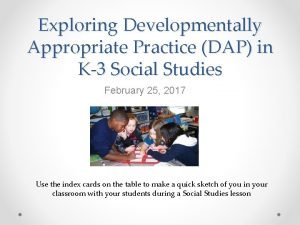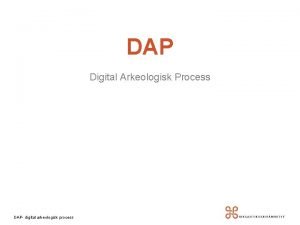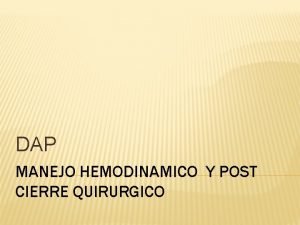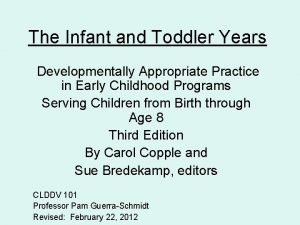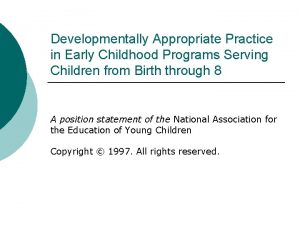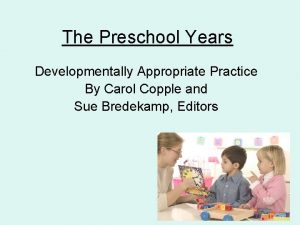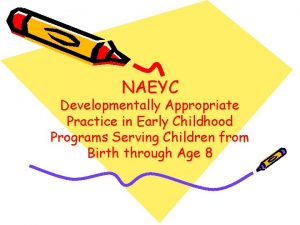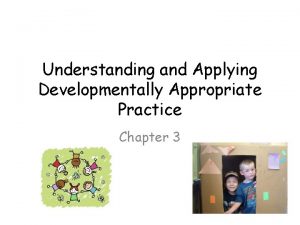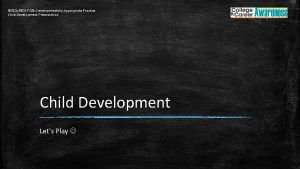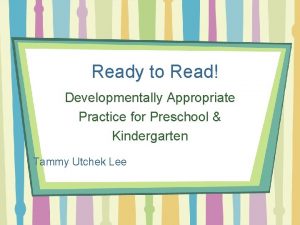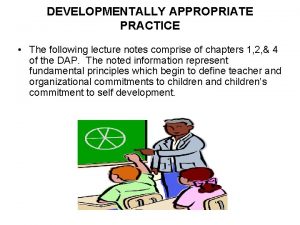Developmentally Appropriate Practice DAP EDU 370 Kindergarten Methods
































- Slides: 32

Developmentally Appropriate Practice (DAP) EDU 370 Kindergarten Methods Fall 2014

3 Core Considerations O Knowing about child development and learning. O Knowing what is individually appropriate. O Knowing what is culturally important.

12 Principles of Child Development and Learning that Inform Practice O O O All areas of development and learning are important. Learning and development follow sequences. Development and learning proceed at varying rates. Development and learning result from an interaction of maturation and experience. Early experiences have profound effects on development and learning. Development proceeds toward greater complexity, self-regulation, and symbolic or representational capacities. Children develop best when they have secure relationships. Development and learning occur in and are influenced by multiple social and cul¬tural contexts. Children learn in a variety of ways. Play is an important vehicle for devel¬oping self-regulation and pro¬moting language, cognition, and social competence. Development and learning advance when children are challenged. Children’s experiences shape their motivation and approaches to learning.

5 Guidelines for Effective Teaching O 5 key aspects of the teacher's role: O Creating a caring community of learners O Teaching to enhance development and learning O Planning curriculum to achieve important goals O Assessing children's development and learning O Establishing reciprocal relationships with families

10 Effective DAP Teaching Strategies O As we discuss the teaching strategies consider the developmental theories that support each!

1 O Acknowledge what children do or say. Let children know that we have noticed by giving positive attention, sometimes through comments, sometimes through just sitting nearby and observing. (“Thanks for your help, Kavi. ” “You found another way to show 5. ”)

2 O Encourage persistence and effort rather than just praising and evaluating what the child has done. (“You’re thinking of lots of words to describe the dog in the story. Let’s keep going!”)

3 O Give specific feedback rather than general comments. (“The beanbag didn’t get all the way to the hoop, James, so you might try throwing it harder. ”)

4 O Model attitudes, ways of approaching problems, and behavior toward others, showing children rather than just telling them (“Hmm, that didn’t work and I need to think about why. ” “I’m sorry, Ben, I missed part of what you said. Please tell me again. ”)

5 O Demonstrate the correct way to do something. This usually involves a procedure that needs to be done in a certain way (such as using a wire whisk or writing the letter P).

6 O Create or add challenge so that a task goes a bit beyond what the children can already do. For example, you lay out a collection of chips, count them together and then ask a small group of children to tell you how many are left after they see you removing some of the chips. The children count the remaining chips to help come up with the answer. To add a challenge, you could hide the chips after you remove some, and the children will have to use a strategy other than counting the remaining chips to come up with the answer. To reduce challenge, you could simplify the task by guiding the children to touch each chip once as they count the remaining chips.

7 O Ask questions that provoke children’s thinking. (“If you couldn’t talk to your partner, how else could you let him know what to do? ”)

8 O Give assistance (such as a cue or hint) to help children work on the edge of their current competence (“Can you think of a word that rhymes with your name, Matt? How about bat. . . Matt/bat? What else rhymes with Matt and bat? ”)

9 O Provide information, directly giving children facts, verbal labels, and other information. (“This one that looks like a big mouse with a short tail is called a vole. ”)

10 O Give directions for children’s action or behavior. (“Touch each block only once as you count them. ” “You want to move that icon over here? Okay, click on it and hold down, then drag it to wherever you want. ”)

Kindergarten is a time of change, challenge, and opportunity. In many ways, kindergartners are still like preschoolers. Yet with the increasing focus on school readiness, many kindergarten classrooms unfortunately bow to pressures and begin to look more like a primary classroom than a kindergarten. Five- and 6 -year-olds make great intellectual leaps. They go through a major shift, allowing them to develop more personal responsibility, self-direction, and logical thinking. This growth affects development across physical, social and emotional, cognitive, and language domains. Kindergarten can shape a child’s overall outlook on and engagement in lifelong learning.

What tomorrow’s teachers should know and be able to do…

O Promoting child development and learning O Building family and community relationships O Observing, documenting, and assessing O Using developmentally effective approaches to connect with children and families O Using content knowledge to build meaningful curriculum O Becoming a professional

Kostelnik: CHAPTER 1 Developmentally Appropriate Practice: An Evolving Framework for Teaching Young Children

Developmentally Appropriate Practices Are: O Age appropriate O Individually appropriate O Socially and culturally appropriate

Jill is 3 Years Old What do you know about Jill based on her age? O Emotional O Cognitive O Language O Social O Physical

Juan is 7 Years Old What do you know about Juan based on his age? O Emotional O Cognitive O Language O Social O Physical

Thinking about Age O How are Jill and Juan likely to differ based on what you know about their ages? O Emotional O Cognitive O Language O Social O Physical

Age Appropriate? Expectation: 3 -year-olds raise their hands to speak at group time 8 -year-olds raise their hands to speak at group time

Individual Differences How might Jill be different from other 3 year-old children? How might Juan be different from other 7 year-old children?

Socio-Cultural Considerations A 3 -week-old calf comes to the program as a visitor. How might the children respond?

Children’s Reactions to the Calf O Children living in a rural community? O Children living in a suburban or urban community?

Children’s Reactions to the Calf O Would you expect all children from the same socio-cultural environment to react in the same way? O What other socio-cultural factors might influence individual children’s reactions?

DAP Requires Judgment O What judgments might play a role in deciding whether a child should be expected to sit with the other children at group time?

Practices that Characterize DAP O Warm relationships O Focus on self-regulation O Whole-child focused O Play is central O Classrooms are flexible and stimulating

DAP Has Been Widely Adopted O Across program settings O Across curriculum models O With children and families from many backgrounds

 10 effective dap teaching strategies
10 effective dap teaching strategies Developmentally inappropriate practices definition
Developmentally inappropriate practices definition Define developmentally appropriate practice
Define developmentally appropriate practice Development occurs in a relatively orderly sequence
Development occurs in a relatively orderly sequence Developmentally appropriate environment
Developmentally appropriate environment Developmentally appropriate curriculum 7th edition
Developmentally appropriate curriculum 7th edition An appropriate developmental curriculum
An appropriate developmental curriculum Developmentally appropriate curriculum 7th edition
Developmentally appropriate curriculum 7th edition Sat10 test
Sat10 test Stanford achievement test kindergarten
Stanford achievement test kindergarten Sat10
Sat10 Sample birp notes
Sample birp notes Fca paritet
Fca paritet Gillman hipaa progress note
Gillman hipaa progress note Fosfato diamonico ficha tecnica
Fosfato diamonico ficha tecnica Ssi vs ssdi
Ssi vs ssdi Dap
Dap Data science dap
Data science dap Montessori adalah
Montessori adalah Types of dap
Types of dap Dap pn
Dap pn What is dap
What is dap 12 prinsip dap
12 prinsip dap Diorfa
Diorfa Dap 1525
Dap 1525 Wax pattern fabrication
Wax pattern fabrication Edu.sharif.edu
Edu.sharif.edu Eecs 496
Eecs 496 Data formats of ibm 360/370
Data formats of ibm 360/370 Ese 370
Ese 370 Gate ese
Gate ese Ese 370
Ese 370 Ese 370
Ese 370
